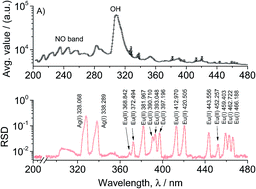当前位置:
X-MOL 学术
›
J. Anal. At. Spectrom.
›
论文详情
Our official English website, www.x-mol.net, welcomes your feedback! (Note: you will need to create a separate account there.)
Feasibility study of particle detection and spectral diagnosis of plasma temperature through suspension introduction Ar-MPT-OES
Journal of Analytical Atomic Spectrometry ( IF 3.4 ) Pub Date : 2017-10-09 00:00:00 , DOI: 10.1039/c7ja00221a Yong-Yang Su 1, 2, 3 , Zhi-Ming Li 1, 2, 3 , Wen-Liang Wang 1, 2, 3 , Jiang Xu 1, 2, 3 , Wei Wang 1, 2, 3 , Xia-Zhi Li 3, 4, 5, 6 , Ze Yu 3, 4, 5, 6
Journal of Analytical Atomic Spectrometry ( IF 3.4 ) Pub Date : 2017-10-09 00:00:00 , DOI: 10.1039/c7ja00221a Yong-Yang Su 1, 2, 3 , Zhi-Ming Li 1, 2, 3 , Wen-Liang Wang 1, 2, 3 , Jiang Xu 1, 2, 3 , Wei Wang 1, 2, 3 , Xia-Zhi Li 3, 4, 5, 6 , Ze Yu 3, 4, 5, 6
Affiliation

|
The Microwave Plasma Torch (MPT) is an excellent excitation source for on-line monitoring of environmental samples. However, the feasibility of particle detection and plasma diagnosis through particle introduction has not been reported yet. In this paper, Eu2O3/Ag and SiO2 suspensions were prepared, characterized and then introduced sequentially into the laboratory-made oxygen shielding argon flow MPT (OS-Ar-MPT) plasma for OES measurements with a time resolution of 6 ms. Signal spikes of Eu, Ag and Si lines from individual particles were observed, respectively, which demonstrates the feasibility of MPT-OES for particle detection. By using the line intensities from signal spikes and the measured sizes, the detection limits of the current instrument for Si, Ag and Eu in individual particles are estimated to be 1.8, 0.15 and 0.19 pg, respectively. The Eu(I) and Eu(II) line intensities extracted from the signal spikes were used to calculate the excitation temperature (Texc) of the OS-Ar-MPT plasma through the Boltzmann slope method. As a comparison study, the Texc was also calculated by using the traditional Fe(I) line Boltzmann slope method through solution introduction. The results show that Texc,Eu-I = 3293 K, Texc,Eu-II = 3414 K, and Texc,Fe-I = 4883 K. Meanwhile, the OH (0,0) band spectrum was simulated by varying the rotational temperature (Trot) by LIFBASE, and then compared with the measured spectrum when the Fe solution was nebulized. The best value of Trot lies between 3100 and 3400 K. Through this work, the capability of Ar-MPT-OES for particle detection is confirmed. Besides, the range of elements suitable for plasma diagnosis is widened and more diagnostic data of MPT plasma temperature are obtained.
中文翻译:

通过悬浮液引入Ar-MPT-OES进行等离子体温度粒子检测和光谱诊断的可行性研究
微波等离子炬(MPT)是用于在线监测环境样品的出色激发源。然而,尚未报道通过粒子引入进行粒子检测和等离子体诊断的可行性。本文中,Eu 2 O 3 / Ag和SiO 2制备,表征悬浮液,然后将其依次引入实验室制造的氧气屏蔽氩气流MPT(OS-Ar-MPT)等离子体中,用于OES测量,时间分辨率为6 ms。分别观察到来自单个颗粒的Eu,Ag和Si线的信号尖峰,这证明了MPT-OES用于颗粒检测的可行性。通过使用来自信号尖峰的线强度和测得的尺寸,当前仪器中单个颗粒中Si,Ag和Eu的检出限估计分别为1.8、0.15和0.19 pg。从信号尖峰提取的Eu(I)和Eu(II)线强度用于计算激发温度(T exc玻尔兹曼斜率法测定OS-Ar-MPT等离子体)。作为比较研究,还通过使用溶液引入通过使用传统的Fe(I)线Boltzmann斜率方法来计算T exc。结果表明,T exc,Eu-I = 3293 K,T exc,Eu-II = 3414 K,T exc,Fe-I = 4883K。同时,通过变化来模拟OH(0,0)谱带用LIFBASE旋转温度(T rot),然后与雾化Fe溶液时的实测光谱进行比较。T rot的最佳价值介于3100和3400 K之间。通过这项工作,证实了Ar-MPT-OES用于粒子检测的能力。此外,扩大了适用于血浆诊断的元素范围,并获得了更多的MPT血浆温度诊断数据。
更新日期:2017-10-09
中文翻译:

通过悬浮液引入Ar-MPT-OES进行等离子体温度粒子检测和光谱诊断的可行性研究
微波等离子炬(MPT)是用于在线监测环境样品的出色激发源。然而,尚未报道通过粒子引入进行粒子检测和等离子体诊断的可行性。本文中,Eu 2 O 3 / Ag和SiO 2制备,表征悬浮液,然后将其依次引入实验室制造的氧气屏蔽氩气流MPT(OS-Ar-MPT)等离子体中,用于OES测量,时间分辨率为6 ms。分别观察到来自单个颗粒的Eu,Ag和Si线的信号尖峰,这证明了MPT-OES用于颗粒检测的可行性。通过使用来自信号尖峰的线强度和测得的尺寸,当前仪器中单个颗粒中Si,Ag和Eu的检出限估计分别为1.8、0.15和0.19 pg。从信号尖峰提取的Eu(I)和Eu(II)线强度用于计算激发温度(T exc玻尔兹曼斜率法测定OS-Ar-MPT等离子体)。作为比较研究,还通过使用溶液引入通过使用传统的Fe(I)线Boltzmann斜率方法来计算T exc。结果表明,T exc,Eu-I = 3293 K,T exc,Eu-II = 3414 K,T exc,Fe-I = 4883K。同时,通过变化来模拟OH(0,0)谱带用LIFBASE旋转温度(T rot),然后与雾化Fe溶液时的实测光谱进行比较。T rot的最佳价值介于3100和3400 K之间。通过这项工作,证实了Ar-MPT-OES用于粒子检测的能力。此外,扩大了适用于血浆诊断的元素范围,并获得了更多的MPT血浆温度诊断数据。



























 京公网安备 11010802027423号
京公网安备 11010802027423号